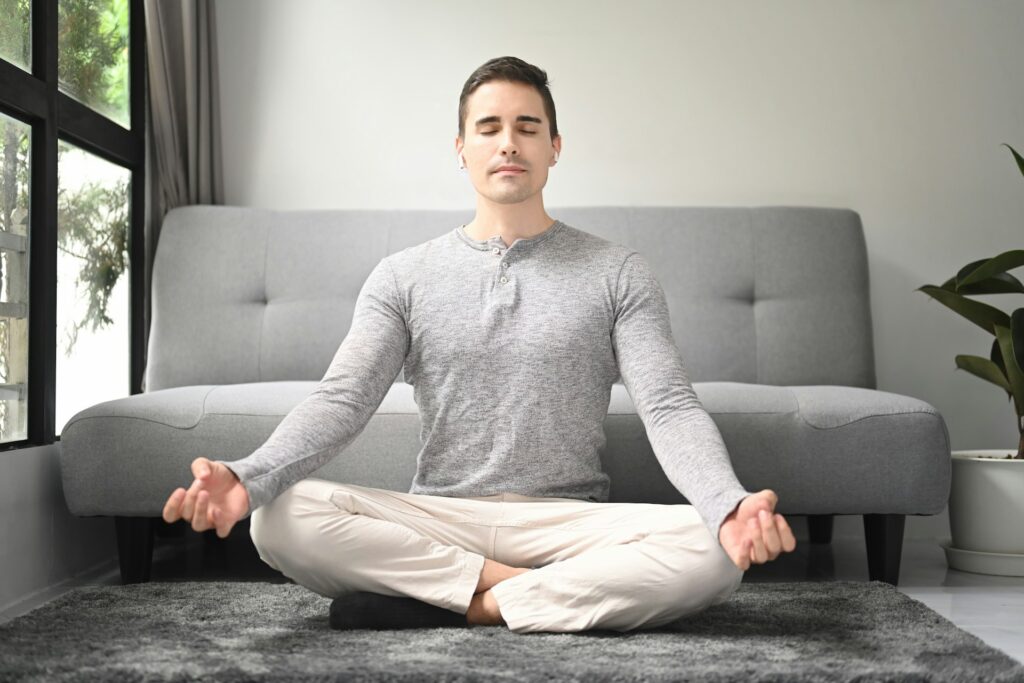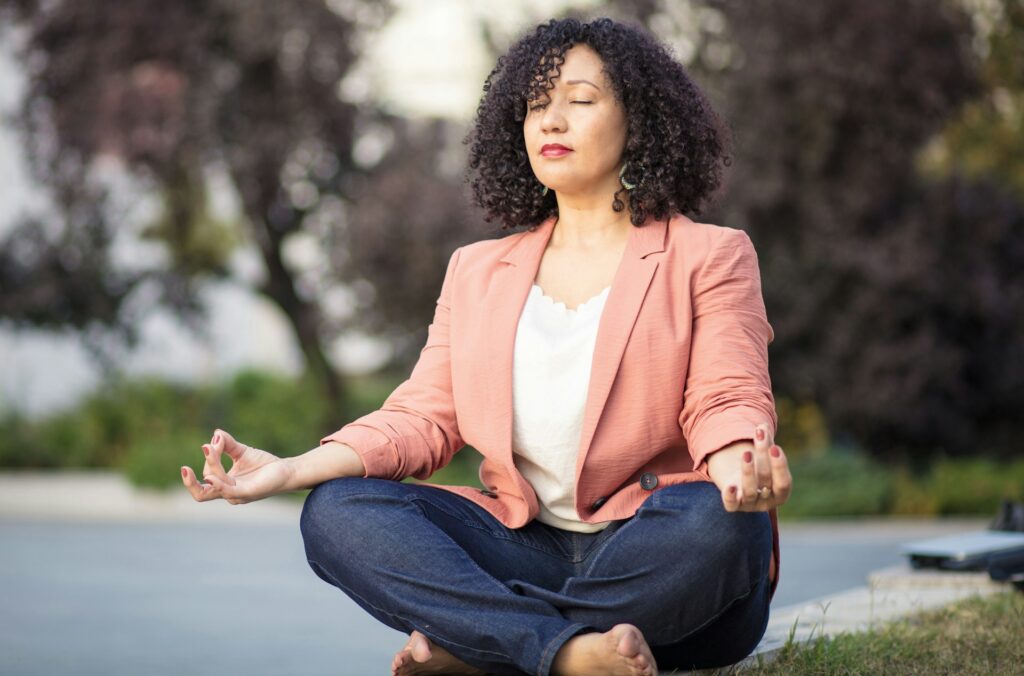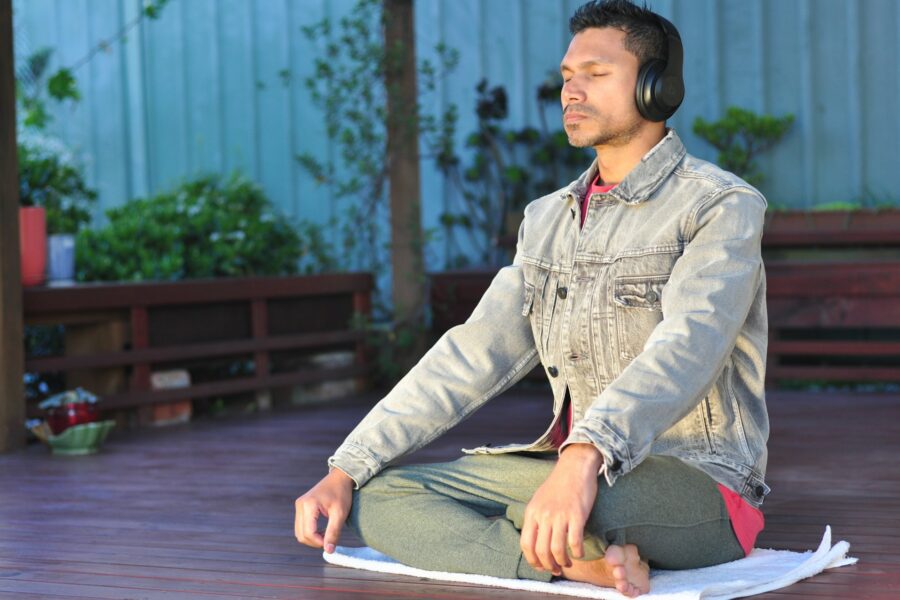There’s this idea that meditation is only for really calm, enlightened people who love sitting in silence for an hour.

In reality, it’s way more normal than that. Meditation is just a way to give your brain a break, to check in with yourself, and to slow down for a few minutes. It doesn’t have to be fancy, serious, or perfect. And it definitely doesn’t need to look like something out of a wellness retreat. If you’ve been curious, but a little intimidated, these eight simple “rules” can help take the pressure off. They’re not rules in a strict sense—just things worth keeping in mind, so the whole thing feels less confusing and way more doable.
1. There’s no such thing as a perfect meditation.

If your brain won’t shut up during meditation, congratulations—you’re normal. Thoughts will pop in. You’ll remember weird things. You’ll wonder if you left the oven on. That’s just part of the deal. Meditation isn’t about clearing your mind completely. It’s more about catching yourself when your thoughts drift and bringing your attention back, without beating yourself up about it.
That little act of noticing and returning? That’s the whole point. You don’t need to zone out or feel zen to be doing it “right.” The fact that you’re showing up and trying, even if it’s messy or awkward, means you’re doing it. Honestly, messy is kind of the norm.
2. Start with however you feel—don’t wait for calm.

People often think you need to be in the right headspace to meditate. But if you only did it when you were calm, you’d probably never do it at all. You can be stressed, tired, restless, or grumpy and still sit down to meditate. In fact, those are probably the times it helps the most.
The idea isn’t to fix how you’re feeling. It’s to just sit with it for a few minutes and see what’s going on. It’s weirdly helpful to just notice your mood without trying to change it. You don’t need to feel chill before you start—meditation is what helps you get there.
3. Short and regular beats long and rare.

Forget the idea that you need to sit cross-legged for 45 minutes every morning. That’s great if it works for you, but it’s not realistic for most people. A few minutes here and there, done often, goes way further than an occasional marathon session.
Consistency is what helps your brain start to trust the process. Even two or three minutes of checking in with yourself can make a difference if you do it regularly. It’s like brushing your teeth—you wouldn’t wait for a full spa day to do it, right? You just do a bit, often, and it adds up.
4. Let your breath be an anchor, not a chore.

Your breath is one of the easiest things to focus on during meditation, but it doesn’t need to be fancy. You don’t have to count it or control it or breathe in some special pattern. Just notice it. That’s it. When your mind wanders off, come back to the breath like you’re gently returning home.
Don’t overthink it. Some days you’ll feel like your breath is steady and grounding. Other days it’ll feel short or choppy. Either way, it’s a way to keep yourself tethered to the present moment without needing a full-blown technique.
5. You’re still meditating even if your mind is noisy.

People bail on meditation all the time because they think it’s not working if their brain is busy. However, the goal isn’t to shut off your thoughts—it’s to stop getting totally carried away by them. You’re learning to notice when your mind is off on a tangent and gently steer it back.
You’ll do this dozens of times during a session, and that’s okay. Each time you notice you’ve drifted and come back, you’re building awareness. You’re not supposed to be a blank slate. You’re just practising not being yanked around by every single thought that shows up.
6. Discomfort doesn’t mean you’re failing.

Meditation can feel weird sometimes. Your legs might go numb. Your back might ache. Your brain might bring up stuff you weren’t expecting. It can feel anything from boring to emotionally heavy, and that’s not a sign it’s not working. That’s just part of what happens when you slow down enough to really sit with yourself.
You’re not broken if it feels uncomfortable. You don’t have to “push through” anything extreme. If you need to shift, move, or open your eyes for a second, do it. There’s no gold star for sitting perfectly still in silence. This is about building tolerance for being with what is, not punishing yourself into stillness.
7. You don’t need a perfect setup.

You don’t need a candle-lit corner, a singing bowl, or special cushions to meditate. Those things can be nice, sure, but they’re not required. You can meditate on a park bench, at your desk, or while lying on the floor in your messy bedroom. The environment doesn’t need to be sacred. It just needs to be somewhere you can sit or lie down without too much distraction for a few minutes.
If having a calming space helps you show up more often, that’s great. But if you’re waiting until your surroundings are just right, you might never start. What really matters is giving yourself permission to pause—wherever you are, however things look.
8. Curiosity is way more useful than judgement.

That voice in your head that says, “This is pointless,” or “You’re doing it wrong,” will show up, guaranteed. Instead of arguing with it or trying to shut it down, just get curious about it. Oh hey, there’s judgement again. Wonder what’s underneath that?
The more you can replace judgement with curiosity, the more spacious meditation feels. You’re not there to impress anyone. You’re just there to check in, notice what’s happening, and maybe understand yourself a little better. Curiosity opens things up. Judgement shuts things down. And the whole point of meditation is to give yourself a little room to breathe—without turning it into another way to beat yourself up.


